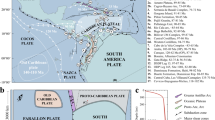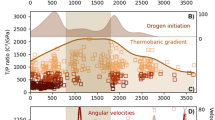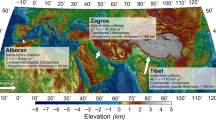Abstract
Stresses acting on cold, thick and negatively buoyant oceanic lithosphere are thought to be crucial to the initiation of subduction and the operation of plate tectonics1,2, which characterizes the present-day geodynamics of the Earth. Because the Earth’s interior was hotter in the Archaean eon, the oceanic crust may have been thicker, thereby making the oceanic lithosphere more buoyant than at present3, and whether subduction and plate tectonics occurred during this time is ambiguous, both in the geological record and in geodynamic models4. Here we show that because the oceanic crust was thick and buoyant5, early continents may have produced intra-lithospheric gravitational stresses large enough to drive their gravitational spreading, to initiate subduction at their margins and to trigger episodes of subduction. Our model predicts the co-occurrence of deep to progressively shallower mafic volcanics and arc magmatism within continents in a self-consistent geodynamic framework, explaining the enigmatic multimodal volcanism and tectonic record of Archaean cratons6. Moreover, our model predicts a petrological stratification and tectonic structure of the sub-continental lithospheric mantle, two predictions that are consistent with xenolith5 and seismic studies, respectively, and consistent with the existence of a mid-lithospheric seismic discontinuity7. The slow gravitational collapse of early continents could have kick-started transient episodes of plate tectonics until, as the Earth’s interior cooled and oceanic lithosphere became heavier, plate tectonics became self-sustaining.
This is a preview of subscription content, access via your institution
Access options
Subscribe to this journal
Receive 51 print issues and online access
$199.00 per year
only $3.90 per issue
Buy this article
- Purchase on Springer Link
- Instant access to full article PDF
Prices may be subject to local taxes which are calculated during checkout



Similar content being viewed by others
References
Bott, M. H. P. Modelling the plate-driving mechanism. J. Geol. Soc. Lond. 150, 941–951 (1993)
Faccenna, C., Giardini, D., Davy, P. & Argentieri, A. Initiation of subduction at Atlantic-type margins: insights from laboratory experiments. J. Geophys. Res. 104, 2749–2766 (1999)
Sleep, N. H. & Windley, B. F. Archean plate tectonics: constraints and inferences. J. Geol. 90, 363–379 (1982)
van Hunen, J. & Moyen, J. F. Archean subduction: fact or fiction? Annu. Rev. Earth Planet. Sci. 40, 195–219 (2012)
Griffin, W. L., O’Reilly, S. Y., Afonso, J.-C. & Begg, G. C. The composition and evolution of lithospheric mantle: a re-evaluation and its tectonic implications. J. Petrol. 50, 1185–1204 (2009)
Wyman, D. A., Kerrich, R. & Polat, A. Assembly of Archean cratonic mantle lithosphere and crust: plume–arc interaction in the Abitibi–Wawa subduction accretion complex. Precambr. Res. 115, 37–62 (2002)
Yuan, H. & Romanowicz, B. Lithospheric layering in the North American craton. Nature 466, 1063–1068 (2010)
Martin, H., Smithies, R. H., Rapp, R., Moyen, J. F. & Champion, D. An overview of adakite, tonalite–trondhjemite–granodiorite (TTG), and sanukitoid: relationships and some implications for crustal evolution. Lithos 79, 1–24 (2005)
Polat, A., Hofmann, A. W. & Rosing, M. T. Boninite-like volcanic rocks in the 3.7–3.8 Ga Isua greenstone belt, West Greenland: geochemical evidence for intra-oceanic subduction zone processes in the early Earth. Chem. Geol. 184, 231–254 (2002)
Harrison, T. M. et al. Heterogeneous Hadean hafnium: evidence of continental crust at 4.4 to 4.5 Ga. Science 310, 1947–1950 (2005)
van Thienen, P., Vlaar, N. J. & van den Berg, A. J. Assessment of the cooling capacity of plate tectonics and flood volcanism in the evolution of Earth, Mars and Venus. Phys. Earth Planet. Inter. 150, 287–315 (2005)
Moresi, L., Dufour, F. & Muhlhaus, H.-B. A Lagrangian integration point finite element method for large deformation modeling of viscoelastic geomaterials. J. Comput. Phys. 184, 476–497 (2003)
Nikolaeva, K., Gerya, T. V. & Marques, F. O. Subduction initiation at passive margins: numerical modeling. J. Geophys. Res. 115, B03406 (2010)
Bailey, R. Gravity-driven continental overflow and Archaean tectonics. Nature 398, 413–415 (1999)
Rey, P. F. & Coltice, N. Neoarchean lithospheric strengthening and the coupling of the Earth’s geochemical reservoirs. Geology 36, 635–638 (2008)
Bédard, J. H. A catalytic delamination-driven model for coupled genesis of Archaean crust and sub-continental lithospheric mantle. Geochim. Cosmochim. Acta 70, 1188–1214 (2006)
Arndt, N. T., Coltice, N., Helmstaedt, H. & Michel, G. Origin of Archean subcontinental lithospheric mantle: some petrological constraints. Lithos 109, 61–71 (2009)
Zhang, C. et al. Constraints from experimental melting of amphibolite on the depth of formation of garnet-rich restites, and implications for models of Early Archean crustal growth. Precambr. Res. 231, 206–217 (2013)
Huppert, H. E. Propagation of two-dimensional and axisymmetric viscous gravity currents over a rigid horizontal surface. J. Fluid Mech. 121, 43–58 (1982)
Moresi, L. & Solomatov, V. Mantle convection with a brittle lithosphere: thoughts on the global tectonic styles of the Earth and Venus. Geophys. J. Int. 133, 669–682 (1998)
Demouchy, S., Tommasi, A., Ballaran, T. B. & Cordier, P. Low strength of Earth’s uppermost mantle inferred from tri-axial deformation experiments on dry olivine crystals. Phys. Earth Planet. Inter. 220, 37–49 (2013)
Zhong, S. & Watts, A. B. Lithospheric deformation induced by loading of the Hawaiian Islands and its implications for mantle rheology. J. Geophys. Res. 118, 1–24 (2013)
van Hunen, J. & van den Berg, A. P. Plate tectonics on the early Earth: limitations imposed by strength and buoyancy of subducted lithosphere. Lithos 103, 217–235 (2008)
Lenardic, A., Moresi, L.-N. & Mühlaus, H. Longevity and stability of cratonic lithosphere: insights from numerical simulations of coupled mantle convection and continental tectonics. J. Geophys. Res. 108, 2303 (2003)
Sproule, R. A., Lesher, C. M., Ayer, J., Thurston, P. C. & Herzberg, C. T. Spatial and temporal variations in the geochemistry of komatiitic rocks in the Abitibi greenstone belt. Precambr. Res. 115, 153–186 (2002)
Cazenave, A., Souriau, A. & Dominh, K. Global coupling of Earth surface topography with hotspots, geoid and mantle heterogeneities. Nature 340, 54–57 (1989)
Ayer, J. et al. Evolution of the southern Abitibi greenstone belt based on U–Pb geochronology: autochthonous volcanic construction followed by plutonism, regional deformation and sedimentation. Precambr. Res. 115, 63–95 (2002)
Bateman, R., Costa, S., Swe, T. & Lambert, D. Archaean mafic magmatism in the Kalgoorlie area of the Yilgarn Craton, Western Australia: a geochemical and Nd isotopic study of the petrogenetic and tectonic evolution of a greenstone belt. Precambr. Res. 108, 75–112 (2001)
Kind, R., Yuan, X. & Kumar, P. Seismic receiver functions and the lithosphere–asthenosphere boundary. Tectonophysics 536–537, 25–43 (2012)
Rolf, T. & Tackley, P. J. Focussing of stress by continents in 3D spherical mantle convection with self-consistent plate tectonics. Geophys. Res. Lett. 38, L18301 (2011)
O’Neill, C., Moresi, L., Müller, R. D., Albert, R. & Dufour, F. Ellipsis 3D: a particle-in-cell finite-element hybrid code for modelling mantle convection and lithospheric deformation. Comput. Geosci. 32, 1769–1779 (2006)
Brace, W. F. & Kohlstedt, D. L. Limits on lithospheric stress imposed by laboratory experiments. J. Geophys. Res. 85, 6248–6252 (1980)
Byerlee, J. D. Brittle–ductile transition in rocks. J. Geophys. Res. 73, 4741–4750 (1968)
Ord, A. & Hobbs, B. E. The strength of the continental crust, detachment zones and the development of plastic instabilities. Tectonophysics 158, 269–289 (1989)
Escartin, J. & Hirth, G. Nondilatant brittle deformation of serpentinites: implications for Mohr–Coulomb theory and the strength of faults. J. Geophys. Res. 102, 2897–2913 (1997)
Flament, N., Coltice, N. & Rey, P. F. A case for late-Archaean continental emergence from thermal evolution models and hypsometry. Earth Planet. Sci. Lett. 275, 326–336 (2008)
Aoki, I. & Takahashi, E. Density of MORB eclogite in the upper mantle. Phys. Earth Planet. Inter. 143–144, 129–143 (2004)
Hirth, G. & Kohlstedt, D. in Inside the Subduction Factory (ed. Eiler, J. ) 83–105 (Geophysical Monograph no. 138, American Geophysical Union, 2003)
Wang, Y. F., Zhang, J. F., Jin, Z. M. & Green, H. W. Mafic granulite rheology: implications for a weak continental lower crust. Earth Planet. Sci. Lett. 353–354, 99–107 (2012)
Katz, R. F., Spiegelman, M. & Langmuir, C. H. A new parameterization of hydrous mantle melting. Geochem. Geophys. Geosyst. 4, 1073 (2003)
Maaløe, S. The solidus of harzburgite to 3 GPa pressure: the compositions of primary abyssal tholeiite. Mineral. Petrol. 81, 1–17 (2004)
McKenzie, D. & Bickle, M. J. The volume and composition of melt generated by extension on the lithosphere. J. Petrol. 29, 625–629 (1988)
Herzberg, C. & Gazel, E. Petrological evidence for secular cooling in mantle plumes. Nature 458, 619–623 (2009)
Fei, H., Wiedenbeck, M., Yamazaki, D. & Katsura, T. Small effect of water on upper-mantle rheology based on silicon self-diffusion coefficients. Nature 498, 213–216 (2013)
Acknowledgements
We thank W. L. Griffin for comments on the manuscript. P.F.R. acknowledges the assistance of resources provided at the NCI National Facility systems at the Australian National University through the National Computational Merit Allocation Scheme supported by the Australian Government. N.C. was supported by the Institut Universitaire de France, and the European Research Council (ERC) within the framework of the SP2-Ideas Program ERC-2013-CoG, under ERC grant agreement no. 617588. N.C. acknowledges discussions with B. Romanowicz and B. Tauzin. N.F. was supported by Statoil ASA.
Author information
Authors and Affiliations
Contributions
P.F.R. conceived the study. P.F.R. and N.C. performed numerical experiments. P.F.R., N.C. and N.F. interpreted the results. P.F.R., N.C. and N.F. wrote the manuscript.
Corresponding author
Ethics declarations
Competing interests
The authors declare no competing financial interests.
Extended data figures and tables
Extended Data Figure 1 Gravitational force between continent and oceanic lid.
a, Depth profile of the difference in lithostatic pressure σzz between an oceanic lid 150 km thick and a continent (1) 150 km thick, (2) 200 km thick and (3) 250 km thick. The vertical integration of the lithostatic pressure difference (Δσzz) is the resulting gravitational force Fg acting between the Archaean continent and the adjacent lithospheric lid. In all cases, this force is >7 × 1013 N m−1, comparable to or larger than the present-day tectonic forces driving orogenesis1. b, Reference density structure of the continent and oceanic lithosphere (densities of depleted and fertile mantle are from ref. 5). All densities vary with temperature with a coefficient of thermal expansion α = 3 × 10−5 K−1. We assume a linear geotherm in the oceanic plate (T(z = 0) = 293 K, T(z = 150 km) = 1,820 K) above a convective mantle with an average temperature of 1,820 K.
Extended Data Figure 2 Stagnant-lid convection model before lateral averaging and introduction of a continent.
The temperature field in our experiments derives from the lateral averaging of an experiment in which the mantle is allowed to convect under constant upper-boundary temperatures (293 K) and internal production of radiogenic heat (1.36 × 10−8 W m−3). The thermal expansion is 3 × 10−5 K−1, the thermal diffusivity is 0.9 × 10−6 m2 s−1, the heat capacity is 1,000 J kg−1 K−1, and the Rayleigh number of the convecting mantle is between 106 and 107. The snapshot shows the temperature field after ∼1 Gyr of evolution. In this experiment, a lid develops and remains stagnant. Conductive cooling and the formation of cold drips from the lower, unstable part of the stagnant lid balance each other out to maintain the thickness of the stagnant lid. In the lid, the conductive geotherm is such that a temperature of 1,620 K is reached at ∼100 km depth, and 1,820 K (the average temperature in the convecting mantle) is reached at ∼150 km depth.
Extended Data Figure 3 Numerical solutions for various models showing contrasting tectonic evolutions.
A, In this experiment, all parameters are as in Fig. 1 except the continent half-width, which is 500 km. In the case of stable continental collapse, cold drips form faster than subduction can initiate, which stabilizes the oceanic lid. a, Initial state. b, During and after spreading and thinning of the continent, a layer of mostly fertile mantle is accreted at the base of the continent through cooling. B, This experiment is in all aspects similar to that presented in Fig. 1 except for the oceanic lid, which includes 75 km of buoyant lithopheric mantle (in purple) with a reference density of 3,365 kg m−3 (that is, 35 kg m−3 less dense than non-depleted mantle rocks). a, b, Homogeneous continental spreading with decompression melting, and the initiation of a slab that stalls underneath a long-lived orogenic wedge. The same experiment with a buoyant mantle lid with a reference density of 3,370 kg m−3 leads to subduction. c, The very base of the oceanic slab is dragged into the asthenosphere. C, In this experiment the limiting yield stress of the strongly depleted continental mantle (in green) is increased to 500 MPa to take into account the possible plastic strengthening of the depleted—and therefore dry—mantle (all other mantle rocks have a limiting yield stress of 300 MPa). Comparison with Fig. 1—which shows the same experiment but with all mantle rocks having a limiting yield stress of 300 MPa—illustrates that a stronger continent deforms in a more heterogeneous manner. After an episode of spreading, thinning and subduction initiation (b), strain localization and rifting divide the continent in two as the slab detaches (c) before stabilization and cooling (d). D, In this experiment, the continent has a half width of 600 km (a), and all mantle rocks have a limiting yield stress of 200 MPa. b–d, Continental rifting, recurrent slab detachment and trench-retreat occur, and two continental blocks move away from each other with little internal deformation. e, f, Rifting and subduction stop, while cooling re-establishes a stagnant lid. In all cases, a protracted phase of decompression melting lasting several tens of millions of years is coeval with spreading and rifting.
Extended Data Figure 4 Tectonic phase diagram: subduction versus stable-lid regime as a function of yield stress and continent width.
Two series of calculations were performed (with continental thicknesses of 175 and 225 km), systematically varying the half-width of the continent (from 400 to 1,200 km) and the limiting yield stress of all mantle rocks (from 100 to 500 MPa). Depending on the competition between the gravitational driving power of the buoyant continent and the combined viscous resistance of the continent and oceanic lid, the continental collapse may or may not lead to the subduction of the oceanic lid under the continental margin. Coloured dots and the continuous black thick line represent the outcomes of numerical experiments for the 175-km-thick continent. The thick dashed line separates the stable-lid domain from the subduction domain in the case of the 225-km-thick continent. The arrow illustrates that continental rifting, because it reduces the half-width of continents, stabilizes Archaean oceanic lids.
Rights and permissions
About this article
Cite this article
Rey, P., Coltice, N. & Flament, N. Spreading continents kick-started plate tectonics. Nature 513, 405–408 (2014). https://doi.org/10.1038/nature13728
Received:
Accepted:
Published:
Issue Date:
DOI: https://doi.org/10.1038/nature13728
This article is cited by
-
Key geodynamic processes and driving forces of Tethyan evolution
Science China Earth Sciences (2023)
-
Venus, the Planet: Introduction to the Evolution of Earth’s Sister Planet
Space Science Reviews (2023)
-
When and How Plate Tectonics Began?
Journal of Earth Science (2023)
-
The Habitability of Venus
Space Science Reviews (2023)
-
Self-replicating subduction zone initiation by polarity reversal
Communications Earth & Environment (2022)
Comments
By submitting a comment you agree to abide by our Terms and Community Guidelines. If you find something abusive or that does not comply with our terms or guidelines please flag it as inappropriate.



